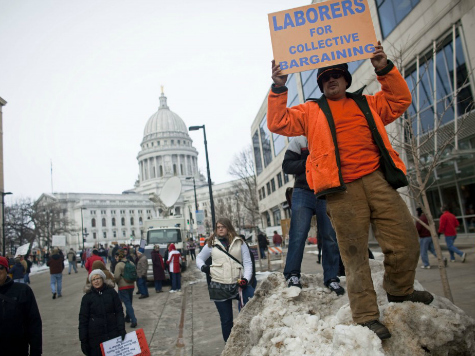
Democrats and union officials usually blame management obstruction, international competition, and the growth of robots for the 80% decline in the percentage of Americans working in the private sector that are unionized.
However, Steve Early, longtime union staff member and prolific socialist writer, just published Save Our Unions: Dispatches From a Movement in Distress which directly blames bloated union overhead costs as a major contributor to the decline of the movement. Early argues the “much expanded role of union staff experts, personnel managers, and outside arbiters” was never downsized as union membership dramatically declined. Early highlights the U.S. ratio of “union officialdom” is now over five times greater than Sweden’s and six times greater than Britain’s. He blames union bosses for spiking dues to protect their own dwindling empires as contributing to declining membership.
Through a series of books, Early has gained a reputation for honestly chronicling the decline of private sector union membership from over 36% after World War II to 6.7% today. In Save Our Unions, he describes how America was so triumphant on the world stage, with its industrial rivals defeated in the wake of the war’s destruction, that the Congress of Industrial Organizations (AFL-CIO today) was able to generate an industrial organizing wave that allowed the number of officials in union bureaucracies to balloon ever-larger.
Early traces union infrastructure growth from very humble beginnings during the Great Depression to the height of the postwar industrial boom in the 1960s when the numbers of union staffers mushroomed: “To operate this system and to maintain a far more decentralized galaxy of contracts… has entailed the growth of union officialdom larger than any other capitalist society… (one [union official] for every 300 workers) as contrasted… to Britain (one for 2000) or in Sweden… (one for every 1,700).”
The growth of union overhead costs initially followed the growth of corporate overhead costs. When profits were high and the growth was easily attained following WWII, corporations grew white-collar management and support staff overhead costs faster than the growth of blue-collar production workers. Approximately 19% of headcount in manufacturing organizations were white-collar management in the 1950s. However, management overhead grew to 24% in 1960, 25% in 1970, 30% in 1980, and peaked at 32% in 1987. Even more devastating to profitability and competitiveness, 90% of corporations during the 1980s economic downturn failed to lay off any white-collar workers, while millions of blue-collar production workers permanently lost their jobs.
The rising cost of management overhead hammered the competitiveness of American manufacturers and contributed to the loss of half of American manufacturing jobs. Businesses that survived began drastic downsizing of both support and management. Each year between 1990 and 1994, half of a million high-paid managers lost their jobs. More than half of these were forced to take employment that paid 30-50% less than their prior jobs. The ratio of production worker to managers in organizations, known as “span of control,” doubled over the next 20 years from seven to one to about fourteen to one today.
As a union staffer in the 1970s himself, Early gives an insider’s view in Save Our Unions of what it was like for idealistic radicals trained in the civil rights and anti-war movement with dreams of a 1930s-style revival of the organizing movement to go to work for unions. Despite continual losses of unionized workers in manufacturing jobs due to international competition and efficiency gains from computers, Early describes top union officials’ “urgency” as focused on maintaining the flow of dues to protect their own jobs. According to Early, “With the goals of the ranks and the leaders often in conflict, something had to give – and the ranks have been doing most of the giving.”
In Save Our Unions, Early is especially incensed by the self-serving antics of the union bosses in a number of modern unions, such as the Service Employees International Union (SEIU) and the International Association of Machinists International (IAM).
SEIU allows local affiliates to employ thousands of non-members as organizers, servicing reps, researchers, education specialists, PR people, and staffers of other kinds of overhead. Although many unions hire and promote from within the ranks of their working members, SEIU continually recruits from the outside. This is especially true in California, where SEIU top-down leadership mandates to hire a “purple army” of non-member officials fostered the revolt that created the competing National Union of Healthcare Workers (NUHW) which is winning elections to decertify and replace the SEIU-United Health Workers union affiliates.
Early views self-preservation as the motivation by IAM union officials to support the January settlement with Boeing that resulted in 30,000 unionized workers voting to give up their defined benefit pensions as paving the way for a further collapse of unions. He points out that the Department of Labor has now confirmed violation of labor election laws during the bitter Boeing negotiations last year by leaders’ “setting union democracy aside at the IAM in their own union elections” in “relentless efforts to preserve their own positions.” With the DOL forcing a rerun of the IAM elections, Early hopes an opposition “workers’ slate” can defeat the “old guard.”
Save Our Unions is a great read for conservatives and liberals because it gives an insider’s view of how the business of union officials is so often in conflict with the needs and aspirations of the workers they represent. Union officials for over a hundred years have blamed management for the decline of union membership. Steve Early exposes how selfish union officials contributed to the 80% decline in union membership.
The author welcomes feedback @ chriss@chrissstreetandcompany.com. Chriss Street is teaching microeconomics at University of California, Irvine this spring from March 31 – June 8, 2014. Call Student Services at (949) 824-5414 or visit http://unex.uci.edu/courses to enroll!

COMMENTS
Please let us know if you're having issues with commenting.